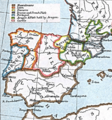Muhammad I of Granada facts for kids
Quick facts for kids Muhammad I |
|
|---|---|
| al-Ghalib biʾllāh | |
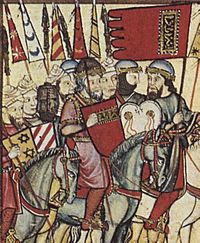
Muhammad I (red tunic and shield) depicted leading his troops during the Mudéjar revolt of 1264–1266 in the Cantigas de Santa Maria
|
|
| Sultan of Granada | |
| Reign | c. 1238 – 22 January 1273 |
| Predecessor | None |
| Successor | Muhammad II |
| Taifa King of Arjona | |
| Reign | 16 July 1232 – c. 1244 |
| Born | c. 1195 Arjona, Almohad Caliphate |
| Died | 22 January 1273 (aged 77–78) near Granada, Emirate of Granada |
| Burial | Alhambra |
| Issue | Muhammad II of Granada |
| House | Nasrid |
| Religion | Sunni Islam (Maliki) |
Muhammad I, also known as Ibn al-Ahmar ("Son of the Red"), was a very important ruler in the history of Spain. He was the first leader of the Emirate of Granada, which was the last independent Muslim state in the Iberian Peninsula. He also founded the Nasrid dynasty, the family that ruled Granada for a long time.
Muhammad I lived when Christian kingdoms like Portugal, Castile, and Aragon were growing stronger. They were taking back land from the Muslim territories in Iberia, a process called the Reconquista.
In 1232, Muhammad I took power in his hometown of Arjona. He rebelled against the main Muslim leader of the time, Ibn Hud. For a short time, he even controlled important cities like Córdoba and Seville. But he soon lost them back to Ibn Hud. Muhammad then agreed to accept Ibn Hud's authority, but he kept control of Arjona and Jaén.
In 1236, Muhammad I changed his alliance. He helped Ferdinand III of Castile, the Christian king, take Córdoba. After this, Muhammad gained control of southern cities like Granada (in 1237), Almería (in 1238), and Málaga (in 1239). Granada became his capital. In 1244, he lost Arjona to Castile. Two years later, in 1246, he gave up Jaén to Ferdinand. In return, he agreed to a 20-year peace treaty and accepted Ferdinand as his overlord.
For the next 18 years, Muhammad I focused on making his kingdom strong. He kept peace with Castile. In 1248, he even helped the Christian kingdom take Seville from the Muslims. But in 1264, he turned against Castile. He supported a rebellion by Muslims who had recently been conquered by Castile. This rebellion was not successful.
In 1266, some of his allies in Málaga, called the Banu Ashqilula, rebelled against him. When these former allies asked for help from Alfonso X of Castile, Muhammad I managed to convince the Castilian general, Nuño González de Lara, to turn against Alfonso. By 1272, Nuño González was actively fighting Castile.
Muhammad I died in 1273 after falling off his horse. The conflict with Castile and the Banu Ashqilula was still ongoing. His son, Muhammad II, became the next ruler.
The Emirate of Granada, which Muhammad I founded, and the Nasrid family ruled for over 200 more years. It was finally taken by Castile in 1492. Muhammad I also started building the Alhambra palace in Granada. His family continued to build it, and it is still a famous and beautiful building today.
Contents
Early Life and Family Background
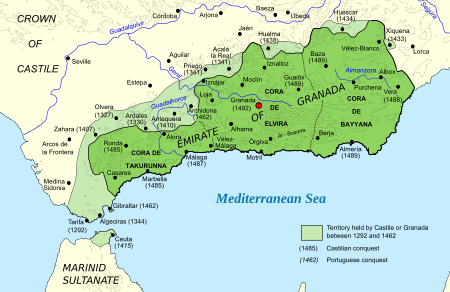
Muhammad ibn Yusuf was born in 1195 in Arjona. This was a small Muslim town in what is now Spain. He came from a simple background. One old Spanish book says he started out "following the oxen and the plough."
His family was known as the Banu Nasr or Banu al-Ahmar. A historian named Ibn al-Khatib said his family came from a friend of the Islamic prophet Muhammad. This friend's descendants moved to Spain and became farmers in Arjona. As a young man, Muhammad became known for his leadership skills. He was also seen as a very religious person. He kept this religious image even after he became a ruler.
Muhammad I was married to his cousin, Aisha bint Muhammad, around 1230. They had several children. Their first son, Faraj, died young, which made Muhammad very sad. Their other children included Yusuf (who also died before his father) and Muhammad, who would become Muhammad II. They also had two daughters, Mu'mina and Shams. Muhammad I had a brother named Ismail, who was governor of Málaga. Ismail's family line later produced other sultans of Granada.
The Political Situation in Iberia
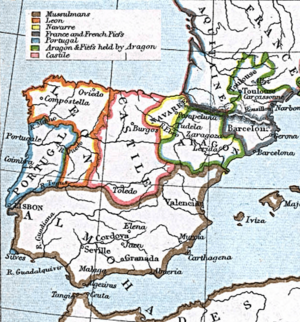
The early 1200s were a difficult time for Muslims in the Iberian Peninsula. The Almohad caliphate, which had ruled Muslim Spain, broke apart after its leader died in 1224. Muslim Spain, called Al-Andalus, split into many small kingdoms called taifas.
One of these taifa leaders was Ibn Hud. He rebelled against the Almohads and became the main ruler of Al-Andalus for a while. But Ibn Hud also lost battles against the Christian kingdoms. He lost cities like Badajoz and Extremadura.
In the north of the peninsula, there were several Christian kingdoms: Castile, León, Portugal, Navarre, and the Crown of Aragon. These kingdoms were expanding south into Muslim lands. This process was called the Reconquista. By the mid-1200s, Castile was the largest kingdom. Its king, Ferdinand III, used the disunity among Muslims to conquer more territories. He took Córdoba in 1236 and Seville in 1248.
Muhammad's Rise to Power
Ibn Hud's defeats made him less popular. Rebellions started in his lands, including in Muhammad's hometown of Arjona. On July 16, 1232, the people of Arjona declared their independence. They chose Muhammad as their leader. He was known for his strong faith and his fighting skills against the Christians. Muhammad also had the support of his family, the Banu Nasr, and another allied family, the Banu Ashqilula.
In the same year, Muhammad took Jaén, an important city near Arjona. With help from Ibn Hud's rivals, Muhammad briefly took control of Córdoba. He also took Seville in 1234, but he only held it for one month. Both Córdoba and Seville were not happy with Muhammad's rule. They soon returned to Ibn Hud's control. After these setbacks, Muhammad again declared his loyalty to Ibn Hud. He kept his rule over a small area including Arjona, Jaén, Porcuna, Guadix, and Baeza.
Muhammad turned against Ibn Hud again in 1236. He made an alliance with King Ferdinand III of Castile. He helped the Castilians capture Córdoba, ending centuries of Muslim rule there. In the years that followed, Muhammad took control of important cities in the south. In May 1237, he was invited by the city's leaders to take Granada. He then made Granada his capital. He also took Almería in 1238 and Málaga in 1239. He gained control of these cities through political deals and the agreement of their people, not always by force.
Ruler of Granada
Building the Alhambra Palace

Muhammad entered Granada in May 1238. Stories say he entered the city dressed simply, like a religious mystic. He moved into the old castle built by earlier rulers. He then looked at an area called al-Hamra, which had a small fortress. Here, he started building his future home and fortress.
Work began on defenses, an irrigation system, and a dike. This construction would continue under his sons and grandsons. This complex became known as the Alhambra. It was the home of all Nasrid rulers until Granada fell in 1492. Muhammad pushed his tax collectors to gather money for the construction. He even used money sent by the Hafsid ruler of Tunis, which was meant for defense against Christians, to expand Granada's main mosque.
Early Conflicts with Castile
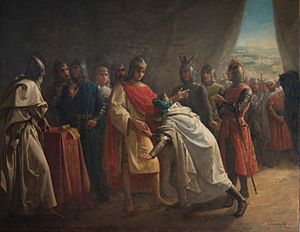
By the late 1230s, Muhammad was the most powerful Muslim ruler in Iberia. He controlled major southern cities like Granada, Almería, Málaga, and Jaén. In the early 1240s, he clashed with his former allies, the Castilians. They were invading Muslim lands. In 1242, Muslim forces successfully raided towns near Jaén. In 1244, Castile attacked and captured Muhammad's hometown of Arjona.
In 1245, King Ferdinand III of Castile attacked the strong city of Jaén. Ferdinand decided to cut off the city's supplies to starve it into surrender. Muhammad tried to send help, but the Castilians stopped him. Because it was so hard to defend Jaén, Muhammad agreed to a deal with Ferdinand. For peace, Muhammad gave up Jaén. He also agreed to pay Ferdinand a large amount of money each year. This agreement was made in March 1246.
As part of the deal, Muhammad had to kiss Ferdinand's hand. This showed that he accepted Ferdinand as his overlord. Christian records say this was a feudal submission, meaning Muhammad and his successors were like vassals to Castile. Muslim records, however, tried to show the relationship as being between equals. After the agreement, the Castilians entered Jaén and forced its Muslim residents to leave.
A Period of Peace and Growth
The peace agreement with Castile lasted for almost 20 years. In 1248, Muhammad showed his loyalty to Ferdinand. He sent soldiers to help the Castilians conquer Seville from the Muslims. In 1252, Ferdinand died, and his son Alfonso X became king.
In 1254, Muhammad attended a meeting of Alfonso's vassals in Toledo. He promised his loyalty and tributes again. During his reign, Alfonso was more interested in other projects, like campaigns in North Africa. He did not want to fight Granada. Muhammad met with Alfonso every year and paid his tributes.
Muhammad used this time of peace to strengthen his new emirate. Even though it was small, the Emirate of Granada was rich and had many people. Its economy relied on farming, especially silk and dried fruit. It traded with Italy and northern Europe. Islamic art, literature, and architecture continued to thrive. The mountains and deserts around Granada helped protect it from Castile. However, its western ports and northwestern routes were less protected.
During his rule, Muhammad placed loyal men in charge of castles and cities. His brother Ismail was governor of Málaga until 1257. After Ismail died, Muhammad appointed his nephew as governor of Málaga.
Growing Tensions with Castile
Peace between Granada and Castile lasted until the early 1260s. Then, Castile's actions started to worry Muhammad. Alfonso built up his military near Granada's territory. In 1261, Castile conquered Jerez de la Frontera, a Muslim city near Granada's border. In 1262, Castile conquered another Muslim area in Spain.
In May 1262, Alfonso asked Muhammad to hand over the port cities of Tarifa and Algeciras. These ports were very important for trade and defense. Muhammad was very worried by this demand. He agreed verbally but kept delaying the transfer. Also, in 1263, Castile forced the Muslim residents out of Écija and brought in Christians.
Because of these actions, Muhammad feared he would be Alfonso's next target. He began talking with Abu Yusuf Yaqub, the Marinid Sultan in Morocco. The Sultan sent troops to Granada. In 1264, Muhammad and 500 knights went to Seville to discuss extending the peace treaty. Alfonso invited them to stay in a palace. During the night, the Castilians locked the area. Muhammad thought this was a trap. He ordered his men to break out and returned to Granada. Alfonso said the barricade was to protect them from thieves, but Muhammad was angry. He ordered his border towns to prepare for war. He also declared himself a vassal of the Hafsid sultan of Tunis.
The Mudéjar Rebellion
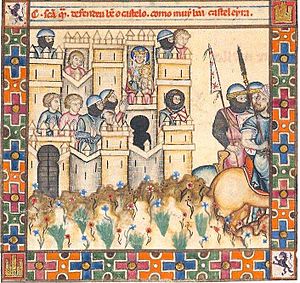
The peace ended in April or May 1264. Muhammad attacked Castile. At the same time, Muslims in Castile's newly conquered lands, called "Mudéjars," rebelled. They were upset about Alfonso's policy of forcing them to move. Muhammad also encouraged their rebellion.
At first, the rebels took control of cities like Murcia and Jerez. But counterattacks by James I of Aragon and Alfonso retook these areas. Alfonso then invaded Granada's territory in 1265. Muhammad soon asked for peace. The peace treaty was very harsh for the rebels. Many Muslims in Andalusia were forced to leave their homes, and Christians moved in.
For Granada, the defeat had mixed results. On one hand, it was clearly defeated. The peace treaty meant it had to pay a much larger annual tribute to Castile. On the other hand, the treaty ensured Granada's survival. It became the only independent Muslim state left in the peninsula. Muslims who were forced out by Castile moved to Granada, which increased its population.
Conflict with the Banu Ashqilula
The Banu Ashqilula family was a very important ally for Muhammad I. They helped him become leader of Arjona in 1232. They also helped him take cities like Seville and Granada. The two families even married each other. Muhammad appointed members of the Banu Ashqilula as governors in his lands, especially in Málaga. Their military strength was key to Granada's power.
By 1266, while Granada was still fighting Castile, the Banu Ashqilula rebelled against Muhammad I. Historians are not sure why this happened. Some think it was because Muhammad named his own sons as heirs, which might have made the Banu Ashqilula feel left out. Others believe the Banu Ashqilula were worried when Muhammad invited North African troops during the 1264 rebellion. They might have felt their own military power was threatened.
Muhammad attacked Málaga but could not defeat the Banu Ashqilula. So, the Banu Ashqilula asked for help from Alfonso X of Castile. Alfonso was happy to support the rebellion to weaken Muhammad. Alfonso sent 1,000 soldiers. Muhammad had to stop his attack on Málaga. The danger of fighting on many fronts led Muhammad to seek peace with Alfonso. In the new agreement, Muhammad gave up his claims to Jerez and Murcia. He also promised to pay a large annual tribute. In return, Alfonso ended his alliance with the Banu Ashqilula and recognized Muhammad's authority over them.
Alfonso was slow to enforce the part about the Banu Ashqilula. So, Muhammad convinced Nuño González, the Castilian general who had helped the Banu Ashqilula, to rebel against Alfonso. Nuño González had his own problems with his king. In 1272, he and his Castilian noble allies began fighting Castile from Granada. Muhammad had successfully taken away Castile's forces and gained allies against the Banu Ashqilula. The Banu Ashqilula agreed to talk about peace.
Before these talks finished, Muhammad was badly hurt after falling from his horse. He died on January 22, 1273, near Granada, during a small military trip. He was buried in a cemetery near the Alhambra. His son, Muhammad II, became the next ruler, just as Muhammad I had planned. Later that year, Muhammad II and Alfonso agreed to a short peace between Granada, Castile, and the Banu Ashqilula.
Muhammad's Legacy

Muhammad I's most important legacy was founding the Emirate of Granada under the Nasrid dynasty. When he died, it was the only independent Muslim state left in the Iberian Peninsula. It lasted for over 200 years until it fell in 1492. The emirate stretched about 240 miles (386 km) from west to east and was about 60 to 70 miles (97 to 113 km) wide from the sea to its northern borders.
During his life, Muslims in Al-Andalus lost a lot of land, including important cities like Córdoba and Seville. A historian named L. P. Harvey said Muhammad "managed to snatch from disaster... a relatively secure refuge for Islam." His rule was marked by his willingness to make compromises, like accepting Castile as his overlord. He also switched alliances between Christians and Muslims to keep Granada independent.
The Encyclopaedia of Islam says that while his rule did not have "spectacular victories," he created a stable government in Granada. He also started building the Alhambra, which is a "lasting memorial to the Nasrids." The Alhambra is now a UNESCO World Heritage Site.
Muhammad's religious views changed over time. At first, he seemed like a religious mystic. He kept this image when he first ruled Granada. But as his rule became stable, he started to follow mainstream Sunni Islam more strictly. He enforced the teachings of the Maliki school of law. This change helped Granada fit in with the rest of the Islamic world. His sons and grandsons continued this approach.
Images for kids
-
Muhammad I (red tunic and shield) depicted leading his troops during the Mudéjar revolt of 1264–1266 in the Cantigas de Santa Maria
-
A map of Southern Spain around Muhammad's time, including the Emirate of Granada which he was to found. Green/pale yellow: Granada.
-
Map of the Iberian peninsula in 1210, before the break up of the Almohad caliphate and the subsequent loss of Muslim territories to the Christian kingdoms
-
Upon entering Granada, Muhammad started the construction of the Alhambra (pictured).
-
Muhammad kissing the hand of Ferdinand III of Castile, while surrendering Jaén and agreeing to be his vassal (1883 painting by Pedro González Bolívar)
-
A Christian-held castle besieged by Muslim troops during the Mudéjar revolt of 1264–1266
-
A bust statue of Muhammad I in his birthplace, Arjona
See also
 In Spanish: Muhammad ibn Nasr para niños
In Spanish: Muhammad ibn Nasr para niños




